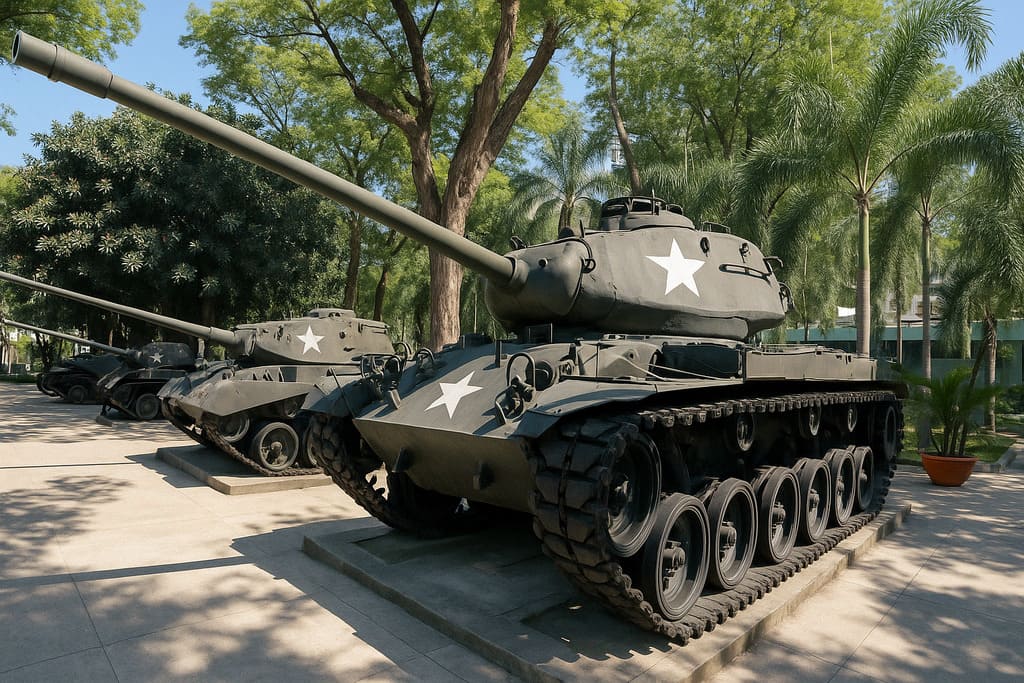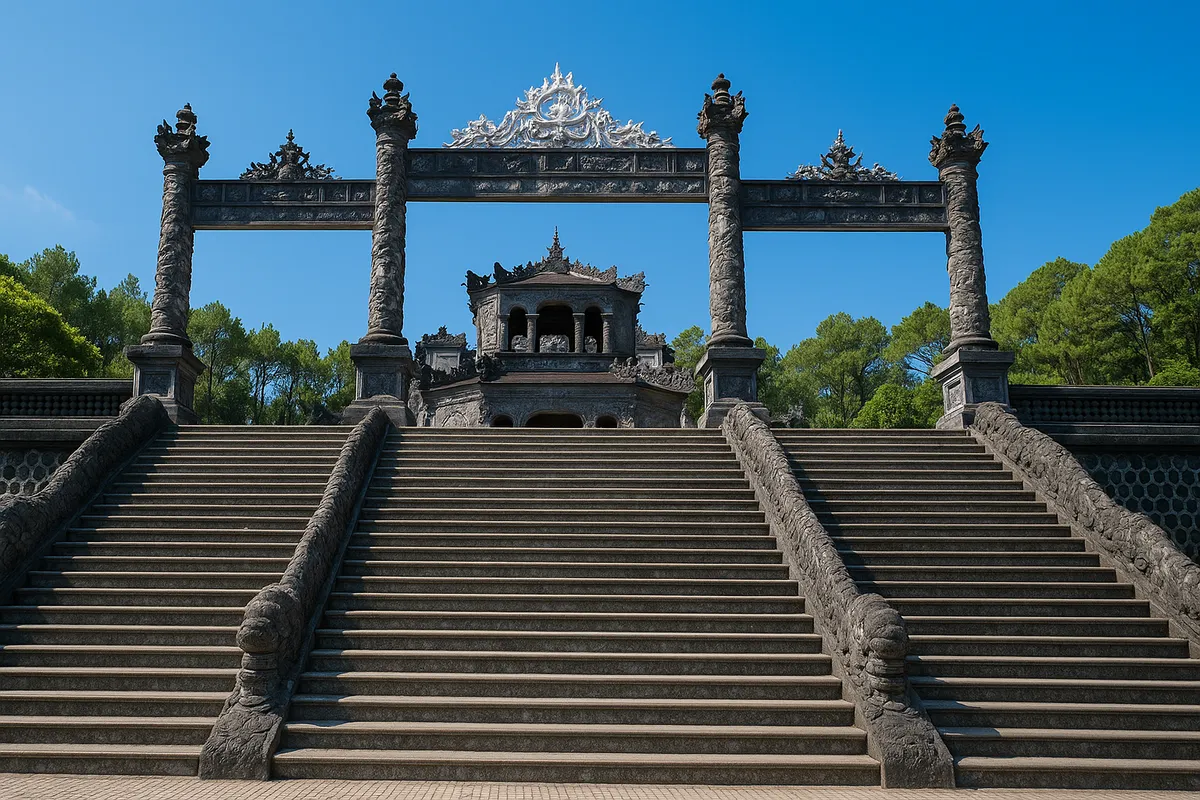Bảo tàng Chứng tích Chiến tranh và tiếng nói ký ức
- Thứ tư, 16/04/2025, 18:04 (GMT+7)
Bảo tàng Chứng tích Chiến tranh và tiếng nói ký ức
Giữa Sài Gòn rực rỡ ánh đèn, nơi tiếng xe hòa vào nhịp sống hiện đại cuồn cuộn không ngơi, có một góc nhỏ tĩnh lặng đến lạ thường. Ở đó, thời gian không trôi nhanh, mà chậm lại từng nhịp để người ta có thể nhìn sâu vào ký ức, vào những vết khắc còn hiện rõ trên tường, trong mắt, và cả trong lòng người. Nơi ấy mang tên Bảo tàng Chứng tích Chiến tranh. Không chỉ là một điểm đến du lịch, đây là hành trình trở về với lịch sử bằng cả trái tim.
Đặt chân đến số 28 Võ Văn Tần, giữa quận 3 đông đúc, thật khó tưởng tượng rằng chỉ cách vài bước chân từ những quán cà phê hiện đại, trung tâm thương mại hào nhoáng lại tồn tại một không gian khắc khoải đến vậy. Cổng bảo tàng không quá đồ sộ, nhưng vừa đủ để bạn cảm nhận một sự nghiêm trang cần thiết. Những tán cây lớn phủ bóng mát như chở che cho ký ức, còn âm thanh của thế giới bên ngoài dường như khựng lại, nhường chỗ cho những lời kể thì thầm từ dĩ vãng.
Ngay từ những bước đầu tiên, bạn sẽ bắt gặp khu trưng bày ngoài trời với xác máy bay, xe tăng, đại bác, những "chứng nhân sắt đá" của chiến tranh. Nhưng cảm xúc thật sự không đến từ những khối kim loại lạnh lùng ấy, mà từ những bức ảnh đen trắng ẩn chứa trong các phòng triển lãm phía bên trong. Mỗi khung hình là một lát cắt tàn khốc, một phần sự thật mà sách giáo khoa chưa từng kể hết. Có những tấm ảnh khiến bạn nín thở thật lâu, rồi khẽ thở ra như thể vừa được sống sót qua một nỗi đau nào đó không thuộc về mình nhưng vẫn để lại dư âm trong lồng ngực.
Gian phòng đặc biệt mang tên “Hậu quả chất độc da cam” luôn khiến tôi dừng lại lâu nhất. Không phải vì tôi tò mò, mà vì tôi thấy mình phải chịu trách nhiệm, như một người trẻ cần biết mình đến từ đâu. Những khuôn mặt méo mó, những cơ thể không trọn vẹn, những ánh mắt vô tội nằm yên trong khung ảnh, tất cả đều im lặng, nhưng lại vang lên tiếng nói mạnh mẽ về hậu quả của chiến tranh kéo dài đến tận hôm nay. Lặng người trước tấm ảnh người mẹ ôm đứa con tật nguyền, tôi chợt nghĩ: liệu có bao nhiêu người từng bước qua nỗi đau này mà vẫn giữ được nụ cười?
Không gian bên trong bảo tàng được chia thành nhiều chủ đề: tội ác chiến tranh, di sản nạn nhân, phong trào phản chiến trên toàn thế giới, và cả những bức thư, nhật ký, bản đồ, hiện vật từ các chiến sĩ và thường dân. Nhưng cách bài trí không hề nặng nề hay khô cứng. Mỗi phòng là một câu chuyện, được kể bằng ngôn ngữ của sự chân thật, bằng ánh sáng dịu và màu tường xám đủ để cảm xúc len lỏi từng bước chân.
Có một khoảnh khắc nhỏ mà tôi nghĩ nhiều người sẽ nhớ mãi khi bạn bắt gặp những dòng viết tay nguệch ngoạc của một đứa trẻ trong vùng chiến sự, hay bản thảo một bài thơ viết dở còn vương vệt máu. Đó là khi bạn hiểu rằng chiến tranh không chỉ lấy đi sinh mạng, nó lấy đi tuổi thơ, ước mơ, cả những điều đẹp đẽ chưa kịp thành hình.
Nhưng không chỉ là những hình ảnh tang thương, Bảo tàng Chứng tích Chiến tranh còn là nơi lưu giữ tinh thần phản chiến mãnh liệt đến từ khắp nơi trên thế giới. Những lá thư của bạn bè năm châu, những chiến dịch vì hòa bình, những tiếng nói đứng về phía sự thật, tất cả tạo nên một niềm tin rằng: dù quá khứ có đau đến đâu, con người vẫn không ngừng hy vọng.
Thời điểm tốt nhất để ghé thăm nơi này là buổi sáng sớm, khi ánh nắng vừa chạm ngưỡng những ô cửa kính, tạo nên một thứ ánh sáng mềm và dịu xuyên qua các bức tường ký ức. Nếu có thể, hãy đi một mình hoặc cùng một người đủ tinh tế để lắng nghe bạn im lặng. Đi chậm, thật chậm, để từng bước chân là một lần lắng lòng, để không bỏ qua một góc nhỏ nào mà lịch sử từng trú ngụ.
Vé vào cửa rất rẻ, chỉ vài chục nghìn đồng, nhưng giá trị tinh thần mà bạn mang về luôn vượt xa con số ấy. Chuyến đi này không cần chuẩn bị nhiều, không cần ăn diện, không cần máy ảnh xịn. Bạn chỉ cần một trái tim đủ rộng mở, một ánh nhìn đủ sâu và đôi tay sẵn sàng không chụp mà chỉ đặt lên tim để cảm.
Có một điều ít người biết, trước năm 1995, nơi đây từng mang tên “Nhà trưng bày tội ác chiến tranh xâm lược Mỹ - Ngụy”. Sau đó, cái tên “Bảo tàng Chứng tích Chiến tranh” ra đời như một cách nhấn mạnh tính khách quan, tinh thần nhân đạo và kêu gọi hòa bình thay vì đối đầu. Chính sự chuyển mình trong cách thể hiện đã biến nơi này trở thành một trong những bảo tàng thu hút nhất châu Á theo bình chọn của TripAdvisor, điều mà ít ai ngờ với một không gian trầm mặc như vậy.
Nếu bạn là người trẻ đang tìm kiếm những tấm hình “xịn xò” để sống ảo, có lẽ đây không phải nơi lý tưởng. Nhưng nếu bạn đang kiếm tìm điều gì đó sâu sắc hơn, thứ khiến bạn suy nghĩ, trăn trở và tự hào về một đất nước đã đứng dậy từ tro tàn, thì nơi đây là điểm đến không thể bỏ qua.
Rời bảo tàng, bước lại ra ánh sáng rực rỡ ngoài kia, tôi thấy lòng mình trĩu xuống nhưng cũng đầy hơn. Có lẽ trong một thời đại mà tốc độ và phô trương dễ khiến người ta quên đi chiều sâu, thì một buổi sáng giữa những chứng tích chiến tranh lại trở thành “điểm chạm” giúp ta trở về đúng nghĩa làm người.
Bởi du lịch không chỉ là để ngắm cảnh đẹp, ăn món ngon, hay check-in ở một quán cà phê lạ. Du lịch đôi khi là để ta đi vào lòng mình, nhìn lại lịch sử, chạm vào ký ức, và rời đi với một trái tim hiểu biết và nhân hậu hơn. Và Bảo tàng Chứng tích Chiến tranh chính là một nơi như thế. Một điểm đến không rực rỡ sắc màu, nhưng đủ sức khiến người ta lặng yên mà nhớ mãi.

 CHECKIN.VN
CHECKIN.VN








Chia sẻ trên